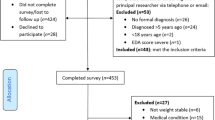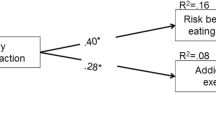Abstract
Aim
In the present study, we aim to assess the prevalence and certain psychological and other correlates of orthorexic tendencies: health and exercise behaviors and demographic variables among gym attendees in Hungary.
Methods
Altogether, responses of 207 gym attendees who filled out an online questionnaire (03/2017–10/2017) were analyzed. The mean age was 31.9 years; most were female and college educated, and about half resided in the capital city. Frequencies and means were calculated for the sample; and univariate linear regression and ANOVA were carried out. Finally, multivariate linear regression was used to assess the relationship between the dependent variable (Orto-11-Hu) and the independent variables (Eating Disorder Inventory, Maudsley Obsessional-Compulsive Inventory, health and exercise habits, and demographics).
Results
The mean score for the Orto-11-Hu was 27.7. In the multivariate analysis, two eating disorder characteristics (drive for thinness and interpersonal distrust), age, exercising more than once a day, and yoga practice were significantly associated with higher orthorexic tendencies. There was a lack of correlation between any obsessive–compulsive traits.
Conclusions
Our data suggest and overlap between certain eating disorder traits, and a link between ON and frequent exercising and younger age. Further research is needed to investigate whether these correlates are found not only in a specific fitness-oriented population, but also in the general population.
Level of evidence
Level V, descriptive cross-sectional study.
Similar content being viewed by others
References
Segura-García C, Papaianni MC, Caglioti F, Procopio L, Nisticò CG, Bombardiere L, Capranica L (2012) Orthorexia nervosa: a frequent eating disordered behavior in athletes. Eat Weight Disord 17(4):226–233. https://doi.org/10.3275/8272
American Psychiatric Association (2013) Diagnostic and statistical manual of mental disorders, 5th edn. American Psychiatric Publishing, Arlington
Bratman S (1997) Original essay on orthorexia. http://www.orthorexia.com/originalorthorexia-essay/. Accessed 5 May 2018
Bratman S (2017) Orthorexia vs. theories of healthy eating. Eat Weight Disord 22:381–385. https://doi.org/10.1007/s40519-017-0417-6
Dunn TM, Bratman S (2016) On orthorexia nervosa: a review of the literature and proposed diagnostic criteria. Eat Behav 21:11–17. https://doi.org/10.1016/j.eatbeh.2015.12.006
Koven NS, Abry AW (2015) The clinical basis of orthorexia nervosa: emerging perspectives. Neuropsychiatr Dis Treat 11:385–394. https://doi.org/10.2147/NDT.S61665
Bratman S, Knight D (2000) Health food junkies. Orthorexia nervosa: overcoming the obsession with healthful eating. Random House, New York
Donini LM, Marsili D, Graziani MP, Imbriale M, Cannella C (2005) Orthorexia nervosa: validation of a diagnosis questionnaire. Eat Weight Disord 10:28–32. https://doi.org/10.1007/BF03327537
Missbach B, Dunn TM, König S (2017) We need new tools to assess Orthorexia Nervosa. A commentary on “Prevalence of Orthorexia Nervosa among College Students Based on Bratman’s Test and Associated Tendencies”. Appetite 108:521–524. https://doi.org/10.1016/j.appet.2016.07.010
Dunn TM, Gibbs J, Whitney N, Starosta A (2017) Prevalence of orthorexia nervosa is less than 1%: data from a US sample. Eat Weight Disord 22:185–192. https://doi.org/10.1007/s40519-016-0258-8
Arusoğlu G, Kabakçi E, Köksal G, Merdol TK (2008) Orthorexia nervosa and adaptation of ORTO-11 into Turkish. Turk Psikiyatri Derg 19:283–291
Alvarenga M, Martins M, Sato K, Vargas S, Philippi S, Scagliusi F (2012) Orthorexia nervosa behavior in a sample of Brazilian dietitians assessed by the Portuguese version of ORTO-15. Eat Weight Disord 17:29–35. https://doi.org/10.1007/BF03325325
Brytek-Matera A, Krupa M, Poggiogalle E, Donini LM (2014) Adaptation of the ORTHO-15 test to Polish women and men. Eat Weight Disord 19(1):69–76. https://doi.org/10.1007/s40519-014-0100-0
Missbach B, Hinterbuchinger B, Dreiseitlb V, Zellhofer S, Kurz C, Konig J (2015) When eating right, is measured wrong! A validation and critical examination of the ORTO-15 questionnaire in German. PLoS One 10:e0135772. https://doi.org/10.1371/journal.pone.0135772
Parra-Fernandez ML, Rodríguez-Cano T, Onieva-Zafra MD, Perez-Haro MJ, Casero-Alonso V, Muñoz Camargo JC et al (2018) Adaptation and validation of the Spanish version of the ORTO-15 questionnaire for the diagnosis of orthorexia nervosa. PLoS One 13(1):e0190722. https://doi.org/10.1371/journal.pone.0190722
Gleaves DH, Graham EC, Ambwani S (2013) Measuring “Orthorexia.” Development of the eating habits questionnaire. Int J Educ Psychol Assess 12(2):1–18
Barrada JR, Roncero M (2018) Bidimensional structure of the orthorexia: development and initial validation of a new instrument. Anales de psicología 34(2):283–291. https://doi.org/10.6018/analesps.34.2.299671
Barthels F, Meyer F, Pietrowsky R (2015) Die Düsseldorfer Orthorexie Skalae Konstruktion und Evaluation eines Fragebogens zur Erfassung orthorektischen Ernahrungsverhaltens. Z Kl Psych Psychoth 44:97–105. https://doi.org/10.1026/1616-3443/a000310
Varga M, Thege BK, Dukay-Szabo S, Tury F, van Furth EF (2014) When eating healthy is not healthy: orthorexia nervosa and its measurement with the ORTO-15 in Hungary. BMC Psychiatry 14:59. https://doi.org/10.1186/1471-244X-14-59
Varga M (2014) Correlates of Orthorexia nervosa, with special focus on eating disorders and obsessive compulsive disorders. Dissertation, Semmelweis University
Rudolph S (2017) The connection between exercise addiction and orthorexia nervosa in German fitness sports. Eat Weight Disord. https://doi.org/10.1007/s40519-017-0437-2
Oberle CD, Watkins RS, Burkot AJ (2018) Orthorexic eating behaviors related to exercise addiction and internal motivations in a sample of university students. Eat Weight Disord 23(1):67–74. https://doi.org/10.1007/s40519-017-0470-1
Brytek-Matera A (2012) Orthorexia nervosa. An eating disorder, obsessive–compulsive disorder or disturbed eating habit? Arch Psychiatry Psychother 14(1):55–60
Brown D (1999) Male bodybuilders and the social meaning of muscle. Auto/Biography 7(1–2):83–91. https://ore.exeter.ac.uk/repository/handle/10036/17594
Cinquegrani B (2018) ‘Wellness’ lifts us above the Food Chaos’: a narrative exploration of the experiences and conceptualisations of orthorexia nervosa through online social media forums. Qual Res Sport Exerc Health 10(5):585–603. https://doi.org/10.1080/2159676X.2018.1464501
Davis C, Kaptein S (2005) Anorexia nervosa with excessive exercise: A phenotype with close links to obsessive–compulsive disorder. Psychiatry Res 142(2–3):209–217. https://doi.org/10.1016/j.psychres.2005.11.006
Riebl SK, Subudhi AW, Broker JP, Schenck K, Berning JR (2007) The prevalence of subclinical eating disorders among male cyclists. J Am Diet Assoc 107(7):1214–1217. https://doi.org/10.1016/j.jada.2007.04.017
Túry F, Sáfrán Z (1997) Az Evési Zavar Kérdőív (Eating Disorder Inventory) hazai adaptációja. Szenvedélybetegségek 5:336–342
Simona Giordano (2005) Understanding eating disorders: conceptual and ethical issues in the treatment of anorexia and bulimia nervosa. Oxford University Press, Oxford
Perczel Forintos D, Kiss Z, Ajtay G (2005) Kérdőívek, becslőskálák a klinikai pszichológiában. OPNI, Budapest
Michalska A, Szejko N, Jakubczyk A, Wojnar M (2016) Nonspecific eating disorders—a subjective review. Psychiatr Pol 50(3):497–507. https://doi.org/10.12740/PP/59217
Barnes M, Caltabiano ML (2016) The interrelationship between orthorexia nervosa, perfectionism, body image and attachment style. Int J Behav Med 22(1):177–184. https://doi.org/10.1007/s40519-016-0280-x
Featherstone M (2010) Body, image and affect in consumer culture. Body Soc 16(1):193–221. https://doi.org/10.1177/1357034X09354357
Håman L, Barker-Ruchti N, Patriksson G, Lindgren EC (2015) Orthorexia nervosa: an integrative literature review of a lifestyle syndrome. Int J Qual Stud Health Well Being 14(10):26799. https://doi.org/10.3402/qhw.v10.26799
Crawford R (1980) Healthism and the medicalization of everyday life. Int J Health Serv 10:365–388
Musolino C, Warin M, Wade T, Gilchrist P (2015) ‘Healthy anorexia’: the complexity of care in disordered eating. Soc Sci Med 139:18–25. https://doi.org/10.1016/j.socscimed.2015.06.030
McCartney M. Margaret, McCartney (2016) Clean eating and the cult of healthism. BMJ 354:i4095. https://doi.org/10.1136/bmj.i4095
Lukacs L (2017) A diéta mint krízis. Mentálhigiéné és Pszichoszomatika 18:2. https://doi.org/10.1556/0406.18.2017.005
Aarnio K, Lindeman M (2004) Magical food and health beliefs: a portrait of believers and functions of the beliefs. Appetite 43(1):65–74. https://doi.org/10.1016/j.appet.2004.03.002
Ross A, Friedmann E, Bevans M, Thomas S (2013) National survey of yoga practitioners: mental and physical health benefits. Complement Ther Med 21(4):313–323. https://doi.org/10.1016/j.ctim.2013.04.001
Barnett MJ, Dripps WR, Blomquist KK (2016) Organivore or organorexic? Examining the relationship between alternative food network engagement, disordered eating, and special diets. Appetite 105:713–720. https://doi.org/10.1016/j.appet.2016.07.008
Bo S, Zoccali R, Ponzo V, Soldati L, De Carli L, Benso A (2014) University courses, eating problems and muscle dysmorphia: are there any associations? J Transl Med 12:221. https://doi.org/10.1186/s12967-014-0221-2
Håman L, Lindgren EC, Prell H (2017) “If it’s not Iron it’s Iron f*cking biggest Ironmen”: personal trainers’s views on health norms, orthorexia and deviant behaviors. Int J Qual Stud Health Well Being 12:1364602. https://doi.org/10.1080/17482631.2017.1364602
Csabai M (2002) Emblems or caricatures? Discourses about hysteria and anorexia nervosa. J Politics Gender Cult 1(2):91–108
Turner PG, Lefevre CE (2017) Instagram use is linked to increased symptoms of orthorexia nervosa. Eat Weight Disord 22(2):277–284. https://doi.org/10.1007/s40519-017-0364-2
Almeida C, Borba EV, Santos L (2018) Orthorexia nervosa in a sample of Portuguese fitness participants. Eat Weight Disord 23(4):443–451. https://doi.org/10.1007/s40519-018-0517-y
Acknowledgements
Dr. Edit Czeglédi for the consultations she provided when analyzing the data in SPSS and Dr. Ferenc Túry for his mentorship.
Funding
Nothing to declare.
Author information
Authors and Affiliations
Contributions
EB recruited the participants and collected their answers; analyzed and interpreted the literature and data; and wrote the manuscript. DK and SzZs helped with data analysis and interpretation and provided comments to the manuscript. AGy designed the study’s statistical model, supervised and contributed to the writing of the manuscript.
Corresponding author
Ethics declarations
Conflict of interest
On behalf of all authors, the corresponding author states that there is no conflict of interest.
Ethics approval
This study was approved by the Hungarian Medical Research Council in January 24, 2017 with the reference number of 3563-1.
Informed consent
All participants were informed at the first page of the questionnaire that the survey is voluntary and anonymous.
Additional information
The article is part of the Topical Collection on Orthorexia Nervosa.
Rights and permissions
About this article
Cite this article
Bóna, E., Szél, Z., Kiss, D. et al. An unhealthy health behavior: analysis of orthorexic tendencies among Hungarian gym attendees. Eat Weight Disord 24, 13–20 (2019). https://doi.org/10.1007/s40519-018-0592-0
Received:
Accepted:
Published:
Issue Date:
DOI: https://doi.org/10.1007/s40519-018-0592-0




